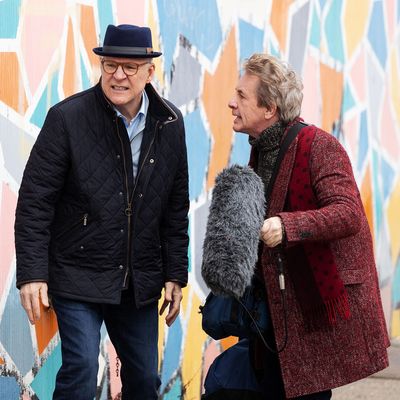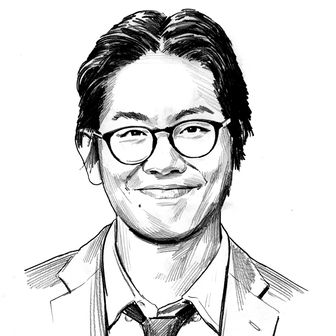
A confession: When it comes to true crime, I’m prone to pearl-clutching. Historically speaking, the genre has never sat well with me, and I have spent a good amount of emotional energy lamenting what it says about us that the brutal end of a human being’s life so often becomes the basis of so much entertainment for others.
Sure, I’m cognizant of the arguments in favor: how there exists some forms of true crime that have led to breakthroughs in wrongful conviction cases and increased awareness of ineffective policing, how in recent years the genre has been reclaimed by some enthusiasts as a source of strength and empowerment, and so on. But on most days, I tend to be the kind of person who would militantly argue that the many moral quandaries of true crime in its entirety — its tendency to suffer from missing-white-woman syndrome, how it can perpetuate the myth of effective policing, how “true-crime brain” can lead to a distinctly harmful, conspiratorial way of thinking — are so insurmountable as to render the genre irredeemable.
And yet I am also a big, stinking hypocrite. Like millions of others on this planet, I consume a substantial amount of true-crime media, often compulsively. To be fair, this partly has to do with the simple ubiquity of true crime, but the fact remains that I routinely take pleasure in listening to murder podcasts, reading magazine features about murders, and watching any number of the many, many fine (and not-so-fine) murder docs on various streaming services, even as I occasionally slip into wondering how horrible my family would feel if I was ever to be brutally murdered and made the subject of a grimdark HBO docuseries.
There are the lies I tell myself, of course. That I only seek out the good ones, the “prestige” ones, the artfully done ones that aspire to some larger idea about society, justice, and the world, that kind of thing.
This is why I had such fondness for American Vandal, Dan Perrault and Tony Yacenda’s Netflix mockumentary series whose debut season earned critical acclaim (and a Peabody!) for its vivid depiction of high school and satirical commentary on true crime. While I, a man of culture, also share those highbrow reasons, I was mostly smitten by its ability to extract genuine pathos from a conceit that’s basically one giant dick joke. I felt safe in its parody.
But American Vandal also stuck with me for another reason. The show made its debut in 2017, and its treatment of true-crime tropes effectively renders the production as a time capsule of a certain moment in the genre, specifically as it relates to true-crime podcasts. These days, you can find a different murder pod for every flavor from any number of subgenres, voices, formats, and levels of quality. The charts are so thick with people running around recounting murders that a common refrain these days goes something along the lines of, “If I ever get mysteriously and brutally murdered, please don’t let me become the subject of a true-crime podcast.”
This was not so when American Vandal debuted in the latter days of 2017. At the time, the current genre boom sparked by the wildfire success of Serial, explicitly cited as one of the show’s main influences (alongside docs like Making a Murderer and The Jinx), was only still beginning to shape. Wondery’s Dirty John, which would later kick the podcast-to-television adaptation gold rush into high gear, had just come out. Up and Vanished, arguably the first breakout of the “oops, we solved the murder” amateur podcast-sleuthing phenomenon, was only about a year old, as was My Favorite Murder, the crown jewel of podcasts that firmly fit into what the writer Alice Bolin calls “post-true crime” — i.e., media that is either “explicitly or implicitly about the popularity of the new true-crime wave, questioning its place in our culture, and resisting or responding to its conventions.” It was a stretch of time that, in hindsight, laid the foundation for the more robust and routinized world of true-crime podcasts today.
It should come as no surprise that American Vandal loomed large over my viewing of Only Murders in the Building, Hulu’s mystery-comedy series starring the unlikely trio of Steve Martin, Martin Short, and Selena Gomez as apartment neighbors-turned-amateur true-crime podcasters trying to solve, well, a murder in the building. The two shows remind me of each other for obvious reasons, though Only Murders in the Building is a lot more upfront in its true-crime podcast influence seeing as how the medium is literally woven into its narrative as a tangible plot device. Serial is also referenced in the Hulu series in similarly overt fashion, chiefly in the form of All Is Not Okay in Oklahoma — an all-timer of a fake true-crime podcast name, by the way — and Tina Fey-as-Cinda Canning, obviously a stand-in for Sarah Koenig.
Let me just say: Only Murders in the Building is a marvelous show. It’s the ultimate comfort food, powered by what my colleague Kathryn VanArendonk regarded as a raucous “wouldn’t it be fun?” philosophy that’s rounded out by exceptional costume design, apartments to die for, Big Autumn Energy, and a sizzling Amy Ryan, with bassoon. But while the show is often described as a parody of true crime, that doesn’t quite seem to be true.
It is perhaps more precise to describe Only Murders in the Building not as a true-crime parody, but as a show that puts a spin on the true-crime aesthetic — in the sense that it imagines true crime as something stylish and fashionable. The show isn’t making fun of the genre’s tropes and trappings so much as having fun with them, wearing them as twee decoration. This is a distinction with a difference, I think, because unlike American Vandal, Only Murders in the Building doesn’t actually critique the genre so much as gleefully floats it. It’s amateur sleuthing presented not as a guilty pleasure, but as pleasure, straight up, one that can stand tastefully alongside a night out at the Public Theater.
This is a fascinating vision of true crime. It’s also vaguely distressing. Popular and expansive as the genre might be, true crime still generally exists within a presentation that communicates its inherent moral complication, whether it’s in the sordid (and occasionally campy) style of a DiscoveryID joint, in which case you can comfortably identify the show as a “guilty pleasure,” or in the form of something more prestigious, like a documentary series that bills itself as being about the justice system, in which case you can take in the grisly details under the guise of being socially engaged. Either way, you’re creating a separation away from the subterranean pleasures of true crime. Only Murders is fun fiction, of course, but it presents a vision of the genre that collapses that separation.
Only Murders in the Building does seem to have one plausible line of criticism for its genre inspiration. In the pilot, all three main characters appear to be drawn to solving the murder in their building because each longed to fill a gaping hole in their lives, an idea expressed through brief, lovely, surrealistic vignettes scattered throughout the episode. But these end up simply being the basis of individual arcs for each character, and by the end of the show, the characters are portrayed as having been made whole by their participation in the amateur sleuthing process, which is frankly kind of a wild notion to extend at a moment when the Gabby Petito case, the latest in a long line of instances in which a real-life death attracted intense attention and participation from ordinary strangers to at least some amount of harm, is playing itself out in parallel. (Also, Gomez’s character, Mabel, turns out to be directly connected to the murder in the question, which adds a further layer of justification for the group’s decision to keep the amateur investigation going even as things get dicey.)
In this manner, Only Murders in the Building serves as a curious marker for the contemporary state of true crime, post-Serial, post-Wild Wild Country, post-Tiger King, post-Saturday Night Live’s “Murder Show,” post-countless other true-crime this or that. Only Murders illustrates the way in which the genre has graduated from the tawdry to the twee, a shift in how certain genteel slices of media-consuming culture — one which I count my pearl-clutching self to be a part of — has come to embrace its affinity for the genre. It says something that a Hulu show is able to so effectively capture its presumed upper-class viewership’s growing participation in true-crime fandom, complete with a title sequence stylistically inspired by The New Yorker.
Now, I don’t intend to use this opportunity to slink away from my uneasiness with true crime. I’ll keep trying to morally balance ideas of widespread interest in the genre as being both perfectly human and a quandary yet to be fully reckoned with, two things that will probably be held in tension forever.
But I really loved Only Murders in the Building. The show provided a comfortable space for a hypocritical snob like me to come to terms with a world where true crime continues its march forward as an ever-powerful cultural concern. If Steve Martin and Martin Short’s characters can find joy running around trying to solve murders on their own, who am I to feel contempt for those in the real world who do the same? Is it turning me into a true-crime convert? No, I wouldn’t go that far (and yes, obviously, I know these are fictional characters), but the show’s coziness does lull me dangerously close to a point where, if I ever got mysteriously and brutally murdered, I think I’d be okay if someone made a podcast about it.
Then again, I’d be dead.





